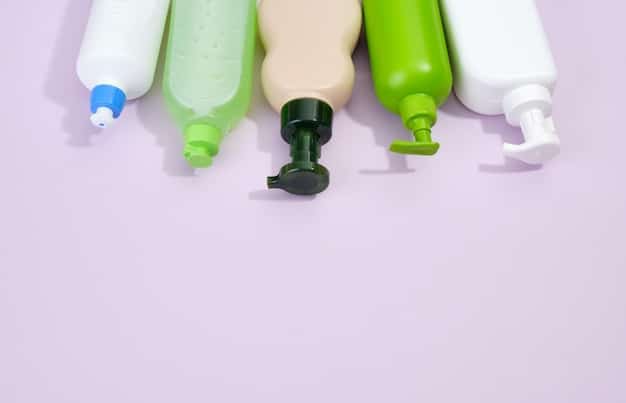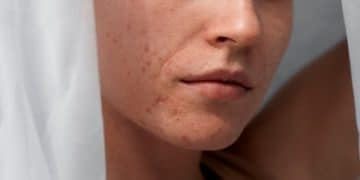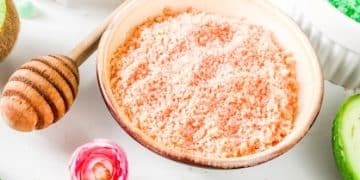The Importance of Cleansing: Choosing the Right Cleanser for Your Skin

Cleansing is a fundamental step in any skincare routine, helping to remove impurities, excess oil, and makeup, which prevents clogged pores, acne breakouts, and promotes healthier, more radiant skin. Choosing the right cleanser ensures effective cleaning without stripping the skin’s natural moisture.
Starting a skincare routine can be overwhelming, but one step should never be skipped: the importance of cleansing: choosing the right cleanser for your skin. It’s the foundation upon which all other skincare efforts are built, paving the way for a healthier and brighter complexion.
The Foundation of Skincare: Why Cleansing Matters
Cleansing is not just about washing your face; it’s about maintaining the health of your skin. A proper cleanse removes dirt, oil, makeup, and pollutants that accumulate throughout the day, preventing clogged pores and potential breakouts. Without this essential step, the skin can become a breeding ground for bacteria and impurities, leading to various skin problems.
Many people underestimate the profound impact of cleansing on their skin’s overall condition. Think of your skin like a canvas: before applying any products, you must cleanse the surface, ensuring it’s free from impurities. This allows subsequent products to penetrate more effectively and deliver their intended benefits. The right cleanser helps maintain the skin’s natural pH balance, which is crucial for a healthy skin barrier.
Preventing Breakouts
One of the primary benefits of regular cleansing is preventing acne and breakouts. Dirt and oil can clog pores, leading to blackheads, whiteheads, and inflamed pimples. By thoroughly cleansing your skin, you remove these pore-clogging agents, reducing the likelihood of breakouts.
Enhancing Product Absorption
Cleansing also enhances the absorption of other skincare products. When the skin is clean, serums, moisturizers, and treatments can penetrate deeper and work more effectively. If your skin is covered with dirt and oil, these products sit on the surface and fail to deliver their full potential.
- Removes Impurities: Cleansing eliminates dirt, oil, and pollutants, keeping your skin clear.
- Prevents Clogged Pores: Regular cleansing prevents the buildup of impurities that lead to acne.
- Prepares Skin for Products: Cleansing ensures that skincare products can penetrate deeper and work effectively.
- Maintains Skin Health: A healthy cleansing routine supports the skin’s natural pH balance and barrier function.
In conclusion, cleansing is a non-negotiable step in skincare. It sets the stage for healthy skin by removing impurities, preventing breakouts, and enhancing the effectiveness of other products. Incorporate a consistent cleansing routine into your daily regimen to reap these benefits and enjoy a clearer, healthier complexion.
Understanding Your Skin Type: A Key to Choosing the Right Cleanser
Before selecting a cleanser, it’s essential to understand your skin type. Different skin types have unique needs, and using the wrong cleanser can lead to irritation, dryness, or excess oil production. Identifying your skin type is the first step toward creating an effective skincare routine and maintaining a healthy complexion. The main skin types are oily, dry, combination, and sensitive, each requiring a specific approach to cleansing.
The beauty industry offers a plethora of cleansers, each promising different results. However, without understanding your skin type, you might end up choosing a product that does more harm than good. For instance, using a harsh cleanser on dry skin can strip away essential oils, leading to dryness and irritation. Conversely, using a gentle cleanser on oily skin might not effectively remove excess oil, leading to clogged pores and breakouts.

Oily Skin
Oily skin is characterized by excessive sebum production, leading to a shiny appearance and a tendency to develop acne. Those with oily skin should look for cleansers that effectively remove excess oil without overly drying the skin.
Dry Skin
Dry skin produces less sebum, resulting in a tight, sometimes flaky complexion. Cleansers for dry skin should be gentle and hydrating, avoiding harsh ingredients that strip away natural oils. Look for creamy, moisturizing cleansers that replenish the skin’s moisture barrier.
- Oily Skin: Look for foaming or gel cleansers with ingredients like salicylic acid or tea tree oil.
- Dry Skin: Choose creamy or oil-based cleansers with hydrating ingredients like hyaluronic acid or glycerin.
- Combination Skin: Opt for a gentle, balanced cleanser that cleanses without stripping or adding excessive moisture.
- Sensitive Skin: Select fragrance-free, hypoallergenic cleansers with soothing ingredients like chamomile or aloe vera.
In conclusion, understanding your skin type is paramount when choosing a cleanser. The right cleanser will effectively cleanse your skin without disrupting its natural balance, leading to a healthier and more radiant complexion. Take the time to assess your skin, and select a cleanser that caters to its specific needs.
Decoding Cleanser Ingredients: What to Look For and Avoid
Navigating the world of cleanser ingredients can be overwhelming, but knowing what to look for and avoid is crucial for maintaining healthy skin. The ingredients in your cleanser can significantly impact your skin’s health, either enhancing hydration and clarity or causing irritation and dryness. Understanding the common ingredients in cleansers allows you to make informed decisions and choose products that best suit your skin’s needs.
Ingredients like sulfates, parabens, and artificial fragrances can irritate sensitive skin, while hydrating ingredients like hyaluronic acid, glycerin, and ceramides can replenish moisture and support the skin’s barrier function. Becoming familiar with these ingredients empowers you to select cleansers that are gentle, effective, and aligned with your skin’s specific needs, ensuring a healthy and glowing complexion.
Beneficial Ingredients
Several ingredients offer significant benefits for the skin. These ingredients can help hydrate, soothe, and protect the skin while effectively cleansing. Look for cleansers that contain these beneficial components to support your skin’s overall health.
Ingredients to Avoid
Certain ingredients can be harsh and irritating, especially for sensitive skin. Avoiding these ingredients in your cleanser can help prevent dryness, redness, and inflammation. Being mindful of these potential irritants can ensure a gentle and effective cleansing experience.
- Hyaluronic Acid: A powerful humectant that attracts and retains moisture, keeping the skin hydrated.
- Glycerin: Another excellent humectant that draws moisture to the skin, preventing dryness.
- Ceramides: Lipid molecules that help restore and maintain the skin’s natural barrier, protecting against environmental aggressors.
- Aloe Vera: Known for its soothing and anti-inflammatory properties, ideal for calming irritated skin.
In summary, paying attention to the ingredients in your cleanser can make a significant difference in your skin’s health. By choosing cleansers with beneficial ingredients and avoiding harsh chemicals, you can create a cleansing routine that supports a healthy and radiant complexion. Educate yourself on common ingredients and tailor your choices to meet your skin’s specific needs.
Different Types of Cleansers: Finding the Perfect Match
The skincare market offers a wide array of cleansers, each designed with specific formulations and textures to cater to various skin types and concerns. From foaming cleansers to oil-based cleansers, understanding the differences between these options is crucial for finding the perfect match for your skin. Exploring each type allows you to make an informed decision and select a cleanser that effectively addresses your unique skincare needs.
Foaming cleansers are great for oily skin, while cream cleansers are ideal for dry skin. Gel cleansers are often preferred for combination skin, and micellar water provides a gentle option for sensitive skin. By understanding the characteristics of each cleanser type, you can choose a product that optimally cleanses your skin without causing irritation or imbalance, promoting a healthy and balanced complexion.

Foaming Cleansers
Foaming cleansers create a rich lather that effectively removes dirt, oil, and makeup. They are often favored by those with oily or acne-prone skin due to their deep-cleansing capabilities.
Cream Cleansers
Cream cleansers are gentle and hydrating, making them suitable for dry or sensitive skin. They cleanse without stripping the skin of its natural oils, leaving it feeling soft and moisturized.
- Foaming Cleansers: Ideal for oily and acne-prone skin, providing a deep clean.
- Cream Cleansers: Perfect for dry and sensitive skin, offering gentle hydration.
- Gel Cleansers: A balanced option for combination skin, effectively removing impurities without causing dryness.
- Micellar Water: A gentle and effective cleanser for all skin types, particularly sensitive skin.
Therefore, choosing the right type of cleanser is crucial for meeting your skin’s specific needs. Whether you opt for a foaming cleanser, a cream cleanser, a gel cleanser, or micellar water, understanding their unique benefits helps you select the perfect match for your skin. By tailoring your cleansing routine to your skin type, you can achieve a clean, balanced, and healthy complexion.
Step-by-Step Cleansing Routine: Achieving Optimal Results
Adopting a structured cleansing routine is essential for maintaining healthy and radiant skin. A well-executed routine ensures that your skin is thoroughly cleansed of impurities, allowing subsequent skincare products to penetrate effectively. Following a step-by-step guide helps you maximize the benefits of cleansing and achieve optimal results.
From removing makeup to using the right water temperature and patting your skin dry, each step plays a crucial role in preserving your skin’s health. By implementing this comprehensive cleansing routine, you can prevent breakouts, maintain a balanced complexion, and enhance the effectiveness of your skincare regimen, ultimately leading to a clearer, healthier, and more vibrant appearance.
Removing Makeup
Before cleansing, it’s essential to remove makeup thoroughly. Use a gentle makeup remover to avoid harsh rubbing or irritation. This step paves the way for the cleanser to work more effectively on your skin.
Cleansing Technique
When cleansing, use lukewarm water and gently massage the cleanser onto your face in circular motions. Avoid hot water, as it can strip your skin of its natural oils. The proper technique ensures a thorough cleanse without causing damage to your skin.
- Start with Makeup Removal: Use a gentle makeup remover to clear your skin.
- Use Lukewarm Water: Avoid hot water, as it can strip your skin of natural oils.
- Massage Gently: Apply the cleanser in circular motions for thorough cleaning.
- Pat Dry: Gently pat your skin dry to avoid irritation.
In conclusion, following a step-by-step cleansing routine is the key to achieving optimal results. By removing makeup, using lukewarm water, massaging gently, and patting dry, you can effectively cleanse your skin and maintain its health. This routine not only ensures that your skin is free from impurities but also enhances the absorption of subsequent skincare products, leading to a more radiant and balanced complexion.
Common Cleansing Mistakes: What to Avoid for Healthy Skin
While cleansing might seem straightforward, several common mistakes can undermine your efforts and lead to skin problems. Recognizing and avoiding these pitfalls is essential for maintaining a healthy and balanced complexion. Steering clear of these mistakes ensures that your cleansing routine supports, rather than hinders, your skin’s overall health and appearance.
Over-cleansing, using harsh products, and neglecting to cleanse at night are among the most frequent errors. These practices can disrupt your skin’s natural barrier, cause irritation, and exacerbate existing skin conditions. By being mindful of these common cleansing mistakes, you can refine your skincare routine and avoid unnecessary damage to your skin.
Over-Cleansing
Cleansing too frequently can strip your skin of its natural oils, leading to dryness and irritation. Stick to cleansing twice a day, morning and night.
Using Harsh Products
Using cleansers with harsh ingredients, such as sulfates and alcohol, can damage your skin’s protective barrier. Opt for gentle, sulfate-free options.
- Over-Cleansing: Cleansing more than twice a day can strip your skin of essential oils.
- Harsh Products: Avoid cleansers with sulfates, alcohol, and artificial fragrances.
- Neglecting Nightly Cleansing: Always cleanse before bed to remove makeup and impurities.
- Using Hot Water: Hot water can strip your skin of natural oils, leading to dryness.
Therefore, being aware of common cleansing mistakes and taking steps to avoid them is crucial for achieving healthy skin. By avoiding over-cleansing, using harsh products, and neglecting nighttime cleansing, you can support your skin’s natural balance and prevent potential damage. Refining your cleansing routine based on these insights will contribute to a healthier, more radiant complexion.
| Key Point | Brief Description |
|---|---|
| ✨ Importance of Cleansing | Removes impurities, prevents breakouts, and enhances product absorption. |
| 🔍 Knowing Your Skin Type | Crucial for choosing the right cleanser that suits your skin needs (oily, dry, combination, sensitive). |
| 🧪 Ingredients to Look For | Hyaluronic acid, glycerin, and ceramides for hydration and skin barrier protection. |
| 🚫 Mistakes to Avoid | Over-cleansing, using harsh products, and neglecting nightly cleansing. |
Frequently Asked Questions
▼
Generally, cleansing twice a day is recommended: once in the morning and once at night. Over-cleansing can strip your skin of essential oils, leading to dryness and irritation.
▼
Foaming or gel cleansers are typically best for oily skin. These formulations help to effectively remove excess oil and impurities without leaving a greasy residue.
▼
Yes, you can use the same gentle cleanser for both morning and night if it suits your skin type. However, at night, ensure it effectively removes makeup and impurities.
▼
Using a toner is optional, but it can help balance your skin’s pH levels and remove any remaining impurities after cleansing. Choose a toner that is alcohol-free and suited to your skin type.
▼
If your skin feels tight after cleansing, it means the cleanser is likely too harsh and stripping your skin of its natural oils. Try switching to a gentler, more hydrating cleanser.
Conclusion
In conclusion, embracing a well-informed and consistent cleansing routine is vital for achieving and maintaining healthy, radiant skin. By understanding your skin type, choosing the right cleanser, and avoiding common mistakes, you can ensure that your skin remains clean, balanced, and protected. Make cleansing a priority in your daily skincare regimen to enjoy a clearer, healthier complexion and to enhance the effectiveness of all other products you use.





